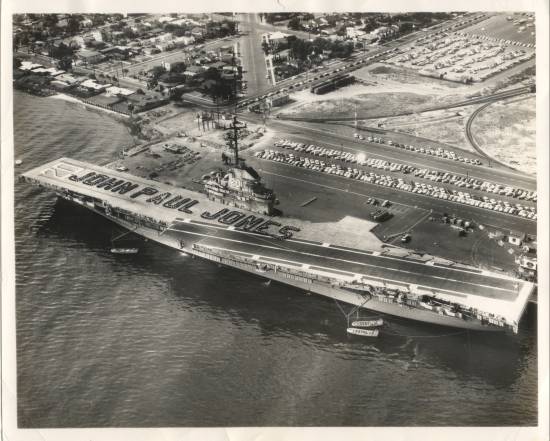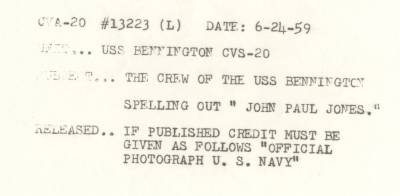PHOTO GALLERY
June 24, 1959
SAN DIEGO
Crew Spells
JOHN PAUL JONES
On Flight Deck
CLICK THE PICTURE FOR A CLOSE UP
CLOSE THE CLOSE UP WINDOW TO RETURN HERE


Subject:
uss bennington cva20
From:
"George Briggs" [geobri@verizon.net]
Date:
Sat, 24 May 2003 17:24:19 -0400
To:
[bennington@uss-bennington.org]
I think they took this picture when the movie came out.
June 24, 1959
Taken at San Diego home port.
George Briggs
Movie Info:
John Paul Jones (1959)
a.k.a "Le capitaine Paul"
The hero of the Revolutionary War clashes with Congress.
Color (Technicolor) | 126 mins.
Cast & Crew
John Farrow
Director
Robert Stack
as John Paul Jones
Marisa Pavan
as Aimee de Tellison
Charles Coburn
as Benjamin Franklin
Erin O'Brien
as Dorothea Danders
MacDonald Carey
as Patrick Henry
Jean Pierre Aumont
as Louis XVI
David Farrar
as John Wilkes
Peter Cushing
as Capt. Pearson
Susan Canales
as Marie Antoinette
Jorge Riviere
as Russian chamberlain
Tom Brannum
as Peter Wooley
Synopsis
On a large Navy frigate, an officer tells new seamen about the legacy of the man who commanded the first ship to carry the U.S. flag into a European port, John Paul Jones:
In 1759, at age twelve, John, from a poor Scottish family, witnesses an English officer disperse townspeople playing the bagpipes, which are viewed as an instrument of war music. When the officer also insults the group by calling the kilt, forbidden by law, a "skirt," John hits the officer in the face with an egg.
Desiring to be master of a ship, John goes to sea and by age seventeen is skilled in navigation. Seeking further experience, he serves on all manner of ships, including slavers, but decides that trafficking in slaves, while lucrative, is not for him. In 1773, John is master of a ship in the West Indies, but when a mutinous crew member dies from a cracked skull after John subdues him in a fight, the governor of Tobago suggests John change his name and leave. Complying, John adds the name "Jones" to his own and goes to Fredericksburg, Virginia to visit his brother William, who owns a business there. John learns from William's clerk and accountant, young Peter Wooley, that his brother died from an illness three months earlier. When John finds that two slave boys, Scipio and Cato, whom his brother planned to free, are in danger of being sold, John vows to see that they will be freed. Wooley suggests that John hire Patrick Henry, a friend of William's, as his lawyer. At a dance, when a British lieutenant haughtily condemns Colonial courage as being no better than the virtue of Colonial women, John slugs him. Afterward, the lieutenant's commanding officer, Capt. Pearson, apologizes for his conduct. When John attempts to flirt with socialite Dorothea Danders, whom Henry is courting, she warns against a "sudden and swift attack." Taken with Dorothea, John decides to stay in Virginia and buy a farm, but he does not take well to farm life. Dorothea's father, who is a member of the resistance with Henry, rejects John as a suitor because of their illustrious ancestors and John's questionable past.
When the war begins, John joins the Continental Navy and, as second-in-command on a battleship in the Bahamas, presents a novel plan to use the Marines in a surprise attack on British troops in Nassau. After the Declaration of Independence is signed, John is assigned his first independent command. He learns that Tories have burned and destroyed his farm and carried off his servants to be sold in Jamaica. John's spirits are raised, however, when his Scottish friend, Duncan MacBean, playing the bagpipes, and Scipio and Cato, playing fife and drums, join Peter in welcoming John's ship. After sailing for Newfoundland, John captures eighteen ships, then gives supplies to Washington's army intended for the British commander General Burgoyne.
After he learns that he no longer can command a ship because he is ranked low among captains, John goes to Valley Forge to deliver his resignation personally to General Washington. When John complains of favoritism and corruption, Washington, whose army suffers from hunger, mutiny and frostbite, castigates him. John then volunteers to serve in any capacity, and Washington sends him to France, hoping that a French alliance could break a possible blockade of the coasts. For his voyage, Washington suggests that John steal the British ship Ranger at Portsmouth, New Hampshire, and gather whatever crew he can get. The ship, on its arrival at Brest, is greeted by the first French cannon fire salute ever given to a ship flying the United States flag. In the company of Benjamin Franklin, John is celebrated in Paris as a hero.
Aimee de Tellison, the illegitimate daughter of the king, Louis XVI, acts as John's guide to the city. Franklin encourages John to take over a frigate built in Holland and invade the British Isles, hoping that the English people will then protest the war and that insurance rates will rise, creating a financial burden for British commerce. After burning the ships and destroying the cannon at the harbor of Whitehaven, John speaks to the citizenry and relates that George III has likewise raided American shores. He vows not to harm any home or person if they make no attempt to fight, and a citizen leader grants them entry. After the raid, Lloyd's of London increases its rates on insuring ships, and members of the House of Commons decry the war. John is feted in Versailles, but at a meeting of the Marine Commission, the Ranger is ordered home as the result of a false report that John could not handle his men, sent by an aristocratic underling whom John had humiliated. After Franklin convinces John to remain in France without a ship, Aimee, moved by John's determination to build a new naval power, suggests to the queen, Marie Antoinette, that the Crown finance a frigate. When Franklin points out that the Crown would benefit from fleets John might capture, Louis agrees to the proposal if the ship sails under the American flag and uses as its name Le Bonhomme Richard , the French title of Franklin's most popular work, Poor Richard's Almanac . During the subsequent battle with Captain Pearson's new ship, The Serafis , the traitorous commander of a ship allied with John fires on Le Bonhomme Richard . As John's men are dying, Pearson asks if he is surrendering, and John calls out, "No sir, I have not yet begun to fight!" Though MacBean, Scipio, and many others on the ship die, Pearson ultimately surrenders because of a fire underneath the magazine. John is awarded a medal and sword at Versailles for his victory, but learns that because Aimee's father is of royal blood, she has been sent away.
After the peace treaty is signed, John is told that present finances will not permit him to form an adequate sea force. While waiting for funds to be issued, he goes to Russia in 1790, as Empress Catherine has applied for the loan of his services. At St. Petersburg, Catherine tempts him with dancing girls, then, convinced of his sense of duty, assigns him to the Black Sea, where Russian ships and crews are in bad condition. After John wins the battle against the enemy's ships and fort, Louis bestows on him the rank of chevalier, which could allow him to marry Aimee.
When John becomes very ill, he travels to Paris, where Aimee writes his last letter for him in which he dictates the qualities needed in a naval officer: he must be a gentleman and have a liberal education, fine manners, courtesy, sense of personal honor, tact, fairness and justice.
The naval commander on the frigate finishes his tale, saying that John's spirit continues to serve and inspire the Navy.
RETURN TO:
INTRODUCTION